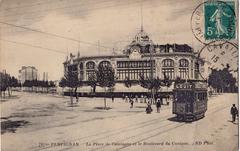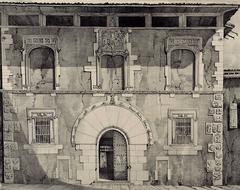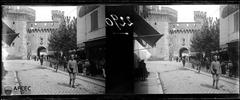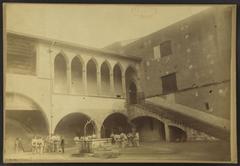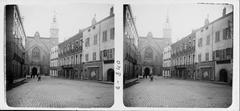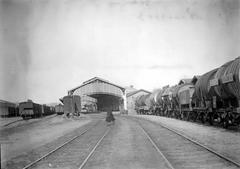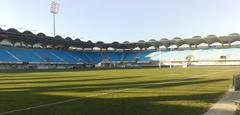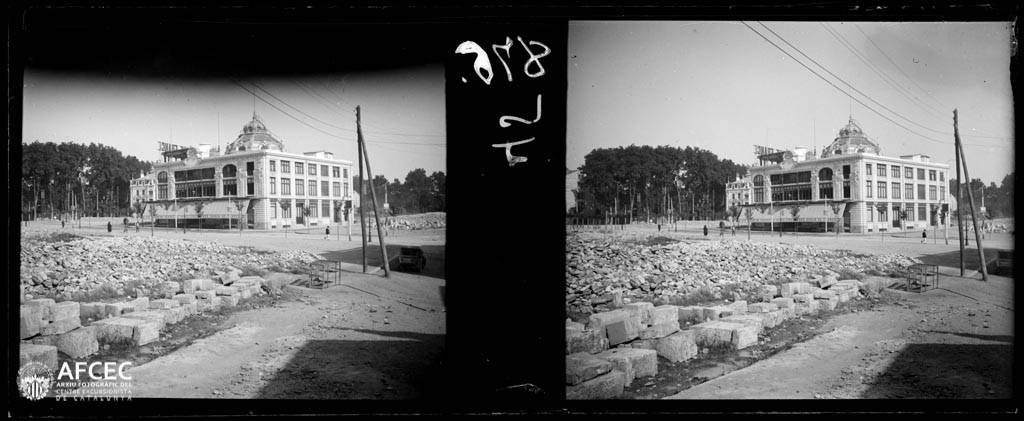
Visiting Place de Catalogne: History, Tickets, and Tips
Date: 01/08/2024
Introduction
Place de Catalogne is a vibrant and historically rich square located in the heart of Perpignan, France. Known as the ‘Capital of French Catalonia,’ Perpignan’s deep historical roots and cultural significance make Place de Catalogne a must-visit destination. This landmark has evolved from a medieval trade hub to a modern-day cultural epicenter, reflecting the dynamic history and diverse architectural styles of Perpignan. Whether you’re interested in the medieval origins of the square, its architectural evolution through the centuries, or its current role as a bustling social and cultural hub, Place de Catalogne offers a unique glimpse into the past and present of Perpignan. This guide aims to provide comprehensive information on visiting Place de Catalogne, including its history, architectural marvels, visitor tips, and cultural highlights, ensuring a memorable and enriching experience for all visitors. For updated information and more details, you can explore resources like Perpignan Tourism and France.fr.
Table of Contents
- Origins and Early Development
- Architectural Evolution
- Cultural Significance
- Modern-Day Place de Catalogne
- Visitor Tips
- Frequently Asked Questions (FAQ)
- Essential Visitor Tips for Exploring Place de Catalogne in Perpignan, France: Hours, Tickets, and More
Origins and Early Development
Place de Catalogne, located in the heart of Perpignan, France, is a significant landmark that embodies the rich history and cultural heritage of the region. Perpignan, often referred to as the “Capital of French Catalonia,” has a storied past that dates back to the Roman era. The city’s strategic location near the Spanish border and the Mediterranean Sea has made it a cultural and commercial crossroads for centuries.
The origins of Place de Catalogne can be traced back to the medieval period when Perpignan was a thriving center of trade and commerce. During the 13th and 14th centuries, the city was part of the Kingdom of Majorca, and it flourished as a hub of political and economic activity. The square itself was established as a central gathering place for merchants, artisans, and residents, serving as a focal point for public life.
Architectural Evolution
Over the centuries, Place de Catalogne has undergone numerous transformations, reflecting the changing architectural styles and urban planning trends of different eras. In the medieval period, the square was characterized by its narrow, winding streets and traditional Catalan buildings. These structures were typically constructed from local materials such as stone and timber, and they featured distinctive elements like arched doorways and wrought-iron balconies.
The 19th century brought significant changes to Place de Catalogne as part of broader urban renewal efforts in Perpignan. Influenced by the Haussmannian style of urban planning that was popular in Paris, city officials sought to modernize the square and its surroundings. This period saw the construction of more spacious boulevards, grand facades, and public amenities designed to enhance the aesthetic appeal and functionality of the area.
Cultural Significance
Place de Catalogne holds a special place in the cultural identity of Perpignan and the broader Catalan region. The square has long been a venue for public celebrations, festivals, and political gatherings, serving as a symbol of the city’s vibrant community life. One of the most notable events associated with Place de Catalogne is the annual “Surrealist Parade,” which celebrates the region’s rich artistic heritage and draws visitors from around the world (Perpignan Tourism).
In addition to its role as a cultural hub, Place de Catalogne is also home to several important historical landmarks. One such site is the Palace of the Kings of Majorca, a medieval fortress that once served as the royal residence for the rulers of the Kingdom of Majorca. Today, the palace is a popular tourist attraction and a testament to the region’s historical significance (France.fr).
Modern-Day Place de Catalogne
In recent years, Place de Catalogne has continued to evolve, blending its historical charm with modern amenities and attractions. The square is now a bustling center of activity, featuring a mix of shops, cafes, and restaurants that cater to both locals and tourists. The area is also known for its vibrant nightlife, with numerous bars and entertainment venues that come alive after dark.
One of the key features of modern-day Place de Catalogne is its accessibility and connectivity. The square is well-served by public transportation, making it easy for visitors to explore other parts of Perpignan and the surrounding region. The nearby TGV train station, designed by renowned architect Jean Nouvel, provides high-speed rail connections to major cities like Paris and Barcelona, further enhancing the square’s appeal as a travel destination (France.fr).
Visitor Tips
Best Time to Visit
The best time to visit Place de Catalogne is during the spring and summer months when the weather is warm and the square is bustling with activity. This is also when many of the city’s festivals and events take place, offering a unique opportunity to experience the local culture.
Exploring the Area
Take the time to explore the surrounding streets and alleys, which are filled with charming shops, cafes, and historical landmarks. Don’t miss the chance to visit the Palace of the Kings of Majorca and the nearby Casa Xanxo, an architectural and heritage interpretation center (Perpignan Tourism).
Dining Options
Perpignan is known for its delicious Catalan cuisine, and Place de Catalogne is home to several excellent restaurants where you can sample local dishes. Be sure to try specialties like boles de Picoulat, bullinada, and vegetable escalivada (France.fr).
Accommodation
There are numerous accommodation options near Place de Catalogne, ranging from budget-friendly hotels to luxurious boutique establishments. Booking in advance is recommended, especially during peak tourist seasons.
Transportation
Utilize the city’s efficient public transportation system to get around. The TGV train station provides convenient access to other major destinations, making it easy to plan day trips to nearby attractions like the Mediterranean coast and the Pyrenees mountains.
Visiting Hours & Tickets
Visitors should check the official tourism websites for the latest information on visiting hours and ticket prices for local attractions, including the Palace of the Kings of Majorca and other historical sites.
Frequently Asked Questions (FAQ)
-
What are the visiting hours for Place de Catalogne?
- The square itself is open 24/7, but specific landmarks like the Palace of the Kings of Majorca have dedicated visiting hours. Check the official tourism websites for the most current information.
-
How much are tickets to Place de Catalogne’s historical sites?
- Ticket prices vary depending on the site. For example, entry to the Palace of the Kings of Majorca is typically around €4-€7. Always check official sources for the latest pricing.
-
What are the top things to do near Place de Catalogne?
- Aside from exploring the square, visitors can enjoy dining at local restaurants, shopping at nearby boutiques, and visiting historical landmarks such as the Palace of the Kings of Majorca and Casa Xanxo.
Essential Visitor Tips for Exploring Place de Catalogne in Perpignan, France: Hours, Tickets, and More
Introduction
Place de Catalogne is a vibrant and iconic square located in the heart of Perpignan, France. Known for its striking architecture and cultural significance, it serves as a central hub for both locals and tourists. Whether you’re interested in historical sites, local cuisine, or simply soaking up the atmosphere, here are some essential tips to make the most of your visit.
Getting There
Place de Catalogne is conveniently located in the heart of Perpignan, making it easily accessible by various modes of transportation. If you are arriving by air, the Aéroport Sud de France Perpignan is just a 15-minute drive from the city center. Alternatively, you can take a 40-minute journey on public transport. For those traveling from further afield, the much busier Josep Tarradellas Barcelona-El Prat Airport is approximately a 2.5-hour drive, a 5-hour bus ride, or a 2-hour train journey away.
Best Time to Visit
Perpignan enjoys a Mediterranean climate, making it a year-round destination. However, the best time to visit Place de Catalogne is during the spring (April to June) and fall (September to November) when the weather is pleasant, and the tourist crowds are thinner. If you visit in September, you can also experience the renowned Visa pour l’Image International Photojournalism Festival, which adds a unique cultural dimension to your trip.
Visiting Hours and Tickets
Place de Catalogne is an open public space, so it does not have specific visiting hours or ticket requirements. However, nearby attractions such as the Palace of the Kings of Majorca and the Perpignan Cathedral may have their own operating hours and ticket prices. It’s advisable to check their individual websites for the most current information.
Accommodation
For a comfortable stay near Place de Catalogne, consider the Ibis Style Perpignan Centre, which is just a 10-minute stroll from the square. This budget-friendly hotel offers colorful fabrics and an all-day bar with a charming garden. For a higher-end experience, the Villa Duflot offers lovely rooms, a swimming pool, and a spa.
Dining Options
Place de Catalogne is surrounded by a variety of dining options that cater to different tastes and budgets. For a communal outdoor dining experience, head to the Halles Vauban, a food hall where you can enjoy fresh oysters, cheese and charcuterie tapas platters, sliders, and artisanal pizzas. For a more formal dining experience, Restaurant L’Osmose on Place Jean Payrat offers sophisticated regional fare like roast guinea-fowl accompanied by a bottle of delicious local Cotes Catalanes rosé.
Shopping
Place de Catalogne is a great spot for retail therapy. The square is home to high-end furniture emporia like Aux Dames de France, a beautiful former art nouveau department store. Here, you can find a variety of unique items, including beach bags embellished with silver or gold ribbon.
Cultural Highlights
One of the most iconic features of Place de Catalogne is the statue of a tiny man on a gigantic red chair, celebrating the surrealist Salvador Dalí. Dalí famously dubbed the nearby Perpignan station the “center of the universe,” making this statue a must-see for art enthusiasts.
Nearby Attractions
While visiting Place de Catalogne, take the opportunity to explore other nearby attractions. The Palace of the Kings of Majorca is a medieval palace offering breathtaking views of the city and surrounding countryside. Another must-visit is the Perpignan Cathedral (Cathédrale Saint-Jean-Baptiste), known for its stunning architecture.
Events and Festivals
Place de Catalogne is a vibrant hub of activity, especially during events and festivals. If you visit during Easter, don’t miss the Procession of the Sanch, a solemn and poignant religious procession. In July, the nearby resort of Le Barcares hosts Les Deferlantes, a major music festival featuring top international names.
Practical Tips
- Language: While French is the official language, you will find that many locals also speak Catalan due to the city’s proximity to Spain.
- Currency: The currency used is the Euro (€). Credit cards are widely accepted, but it’s always a good idea to carry some cash for smaller purchases.
- Safety: Perpignan is generally safe, but like any tourist destination, it’s wise to stay vigilant, especially in crowded areas.
- Local Etiquette: When dining out, it’s customary to greet the staff with a polite “Bonjour” or “Bonsoir” and to thank them with a “Merci” when leaving.
Accessibility
Place de Catalogne is wheelchair accessible, with smooth pavements and ramps available. Public transport in Perpignan is also equipped to accommodate travelers with mobility issues, making it easier for everyone to enjoy the city’s attractions.
Photography
The vibrant atmosphere and unique architecture of Place de Catalogne make it a photographer’s paradise. Whether you’re capturing the iconic Dalí statue or the bustling life around the square, there are plenty of opportunities for stunning shots. Remember to respect local customs and ask for permission if you plan to photograph people.
Souvenirs
Don’t leave Perpignan without picking up some local souvenirs. The nearby Les Toiles du Soleil offers beautifully woven stripey textiles, pottery, and other homewares that make for perfect mementos of your trip.
FAQ
- What are the visiting hours for Place de Catalogne? Place de Catalogne is an open public space and can be visited at any time. However, nearby attractions may have specific visiting hours.
- Are there guided tours available? While there are no specific guided tours for Place de Catalogne itself, many local tours include the square as part of their itinerary. It’s worth checking with local tour operators for more information.
- Is Place de Catalogne wheelchair accessible? Yes, the square is wheelchair accessible with smooth pavements and ramps.
Conclusion
Visiting Place de Catalogne in Perpignan offers an enriching experience that captures the essence of French Catalonia’s rich history and vibrant culture. From its medieval origins to its modern-day attractions, the square serves as a living testament to the region’s dynamic past and present. Whether you’re exploring historical landmarks like the Palace of the Kings of Majorca, indulging in local Catalan cuisine, or enjoying the area’s lively festivals and events, Place de Catalogne has something for everyone. By following the visitor tips and practical advice provided, you can make the most of your trip and create lasting memories. To stay updated on the latest information and events, consider downloading the Audiala mobile app or following related social media channels. For further details, visit Perpignan Tourism and France.fr.
References
- Perpignan Tourism. Tresors caches du XIV eme siecle. https://www.perpignantourisme.com/en/agenda/tresors-caches-du-xiv-eme-siecle/
- France.fr. Perpignan catalan. https://www.france.fr/en/article/perpignan-catalan-0/
- The World Was Here First. Perpignan itinerary. https://www.theworldwasherefirst.com/perpignan-itinerary/
- Places and Things to Do. Perpignan sightseeings. https://placesandthingstodo.com/perpignan-sightseeings/
- The Travel Magazine. Guide to Perpignan Mediterranee, France. https://www.thetravelmagazine.net/guide-to-perpignan-mediterranee-france/

